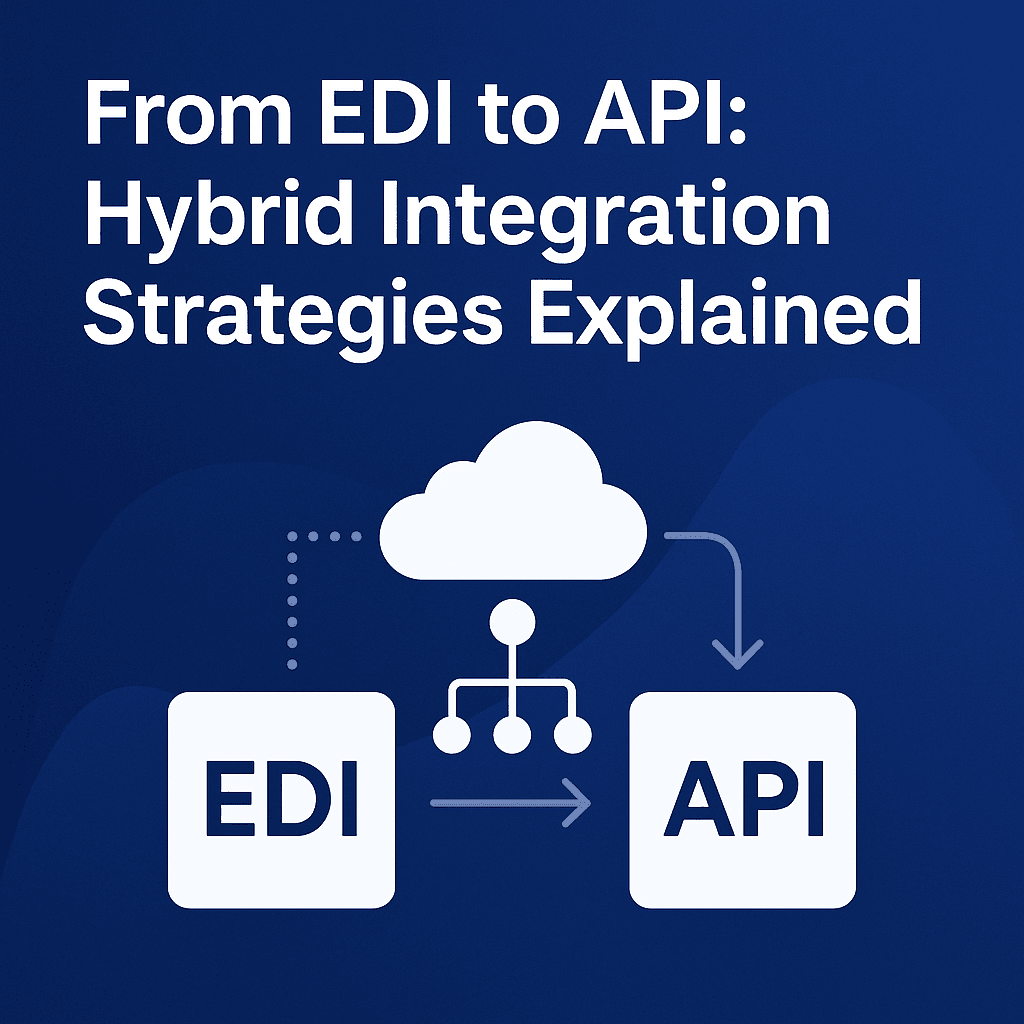Combine the reliability of EDI with the speed of APIs. Learn how hybrid integration modernizes B2B data exchange and enhances supply chain operations.
Electronic data interchange (EDI) has powered global B2B transactions for decades, moving purchase orders, invoices, and shipping details between partners in standardized formats. It remains the backbone of supply chains, but traditional EDI systems can be slow to adapt, expensive to maintain, and limit flexibility. The application programming interface (API) offers a complementary approach, one that enables real-time data exchange, faster onboarding, and easier integration with modern business applications.
Replacing EDI entirely isn’t a viable option for most businesses that operate on a supply chain. Partner requirements, industry standards, and legacy systems make a complete transition unrealistic. Instead, hybrid integration strategies combine the reliability of EDI with the speed and agility of APIs, creating a single environment where both technologies work together. This approach allows companies to modernize their supply chain operations without losing compatibility.
Why Businesses Still Rely on EDI
Electronic data interchange remains a cornerstone of global supply chains because it connects thousands of businesses through well-established, standardized processes. Retailers, suppliers, and third-party logistics (3PL) partners often require EDI for exchanging critical business documents such as purchase orders, invoices, and advance ship notices.
Standardized EDI formats, including ANSI X12 and EDIFACT, ensure compatibility across a vast network of trading partners. This consistency supports reliable communication and ensures that companies meet strict regulatory and contractual obligations. For many organizations, EDI is deeply integrated into core business processes, making it an essential tool for handling mass data exchanges efficiently.
While EDI provides stability and reach, its traditional implementations often lack the speed, flexibility, and real-time visibility that modern operations demand. These gaps create an opportunity for API-based enhancements that preserve EDI’s strengths while expanding your system's capabilities.
What’s the Role of APIs in B2B Integration?
An application programming interface (API) enables two systems to exchange data directly, often in real time. Unlike EDI’s batch processing model, APIs support continuous, bi-directional communication between platforms. This makes them ideal for connecting modern business applications, cloud systems, and mobile tools where speed and flexibility are essential.
Through RESTful APIs and data formats like JSON or XML, businesses can integrate their supply chain processes with external trading partners, order management systems, or ERP platforms more easily. APIs simplify onboarding for new partners, provide real-time access to transaction status, and allow developers to connect other applications without the rigid mapping requirements of traditional EDI.
In a B2B environment, APIs do not replace EDI solutions but enhance them. They add agility to existing workflows, enabling companies to connect systems, automate manual processes, and improve visibility across the entire supply chain.
EDI vs. API: What’s the Difference?
Many businesses searching for EDI vs. API comparisons quickly discover that the real opportunity lies in combining them, not replacing one with the other. While both enable businesses to exchange information with trading partners, they differ in how, when, and where that exchange happens.
Feature | EDI | API |
|---|---|---|
Formats | ANSI X12, EDIFACT, partner-specific formats | JSON, XML, other modern data formats |
Speed | Batch processing at scheduled intervals | Real-time data exchange |
Flexibility | Fixed mappings, limited customization | High flexibility, easier to modify and extend |
Partner coverage | Wide adoption across legacy and modern networks | Growing adoption, especially with modern B2B SaaS partners |
Ideal for | High-volume, standardized transactions like purchase orders and invoices | Real-time visibility, onboarding new trading partners, and connecting modern applications |
When viewed side by side, the contrast is clear. EDI excels at handling mass data in structured, regulated environments, while APIs shine in scenarios that demand speed, flexibility, and real-time access. A hybrid integration strategy allows businesses to capitalize on both strengths in a single, unified approach.
Why It’s Not Either/Or: The Case for Hybrid Integration
In most supply chain environments, EDI is too well-trusted and deeply entrenched to replace, and APIs are too valuable to ignore. A hybrid API/EDI integration strategy uses both, allowing businesses to preserve EDI’s reliability while adding API-driven flexibility.
By integrating an API layer on top of existing EDI systems, companies can modernize without disrupting critical trading partner connections. This API layer enables faster onboarding of new trading partners, provides real-time monitoring and alerts, and reduces testing time through prebuilt maps and standardized data flows. It also simplifies integration with ERP, WMS, and other applications where agility offers a competitive advantage.
Hybrid integration creates an environment where electronic data interchange and APIs work together to improve business processes, shorten onboarding timelines, and keep supply chain operations running smoothly.
How API and EDI Hybrid Strategies Work Together in Practice
In a hybrid EDI and API setup, EDI continues to manage transactions that partners require in standardized formats, such as purchase orders (850) and advance ship notices (856). These documents move through the same trusted channels, ensuring compliance and compatibility with established trading partners.
The API integration works alongside the core EDI software, handling tasks that benefit from speed and flexibility. APIs can transmit data directly into ERP or warehouse management systems in real time and trigger automated alerts when exceptions occur.
For example, a retailer might send an 850 via EDI. Orderful’s platform parses the EDI document, then uses an API to push that order into the ERP. Once processed, the system can respond with an acknowledgment (997) or confirmation (855) as needed. This creates a seamless connection between legacy processes and modern integrations.
A web-based EDI platform further simplifies operations by placing essential components outside the business's internal architecture, offering additional peace of mind when internal systems encounter issues.
Benefits and Use Cases of a Hybrid Approach
Blending EDI and API capabilities gives organizations the best of both worlds. This combination can reshape how companies manage their supply chain operations, connect with partners, and respond to market demands.
Benefits
A hybrid EDI and API strategy offers advantages that go beyond simply connecting systems. Companies often see:
Shorter partner onboarding timelines: APIs simplify the process of connecting with new trading partners, reducing setup time from weeks to days.
Better developer experience: Modern API documentation and tools make integrations easier to build, test, and maintain.
Real-time alerts and visibility: APIs provide instant updates on order status, shipment tracking, and exceptions, enabling faster resolution.
Reduced mapping complexity: Prebuilt mappings cut down the time and effort required for partner-specific EDI formats.
Easier business system integration: APIs connect seamlessly with enterprise systems, ensuring inventory levels and order data stay up to date.
Use Cases
Hybrid integration shines in scenarios where agility and compatibility must coexist:
Onboarding: Connect new trading partners quickly without sacrificing EDI compliance.
Real-time inventory: See availability for customers, sales teams, and fulfillment operations through dashboards and visualization features.
Shipment and ASN tracking: Monitor tracking updates in real time across internal and external systems.
Exception management: System monitoring features alert the right teams instantly when a process breaks.
Cross-platform compatibility: Connect EDI to modern systems like ERP, WMS, or OMS platforms.
When used strategically, these capabilities can improve coordination across teams, reduce friction with trading partners, and keep data flowing smoothly through the entire supply chain.
Challenges to Watch Out For in Hybrid Integration
While hybrid integration brings clear advantages, it also introduces new considerations that businesses need to address. Managing multiple protocols and formats requires careful oversight to avoid data inconsistencies or integration gaps.
Teams must ensure that data remains accurate and consistent across both EDI and API workflows, which often means reinforcing standardized formats and updating validation rules. Training staff on new processes is equally important so they understand how and when to use each integration method.
If systems aren't well-connected, hybrid environments can also lead to siloed operations. A well-implemented strategy should include unified monitoring, shared documentation, and regular audits to keep everything running smoothly.
Testing is crucial for verifying API connectivity with the EDI system and validating the data between them. This helps ensure that the two technologies perform as expected and remain stable over time.
Future-Proof B2B Integration with Hybrid EDI and API
Hybrid integration is more than a stopgap between legacy processes and modern technology. It’s a sustainable way to keep supply chains competitive in a fast-moving market. By combining the reliability of EDI integrations with the agility of an API, businesses can create an environment where each technology enhances the other.
This allows organizations to maintain compliance with trading partner requirements while unlocking new capabilities, such as real-time visibility, faster onboarding, and seamless connectivity with ERP and inventory systems. For many organizations, it offers a way to modernize without the risks and costs of a full system replacement.
Orderful’s platform is built to make this hybrid reality easy to implement and manage. With one platform to handle both EDI and API integrations, you can connect new trading partners faster, monitor transactions in real time, and keep data moving without interruptions. Speak to an expert today and see how a hybrid strategy can work for your business.
EDI API FAQs
What is hybrid integration in EDI?
Hybrid integration in EDI combines traditional electronic data interchange (EDI) with modern APIs to enable both batch and real-time data exchange between trading partners.
How do APIs enhance EDI integration?
APIs enhance EDI integration by enabling real-time visibility, faster onboarding, and seamless connectivity with ERP, WMS, or OMS systems—without replacing EDI.
What are the benefits of a hybrid EDI and API strategy?
A hybrid EDI and API strategy offers real-time data access, reduced onboarding time, easier integration with business systems, and better partner collaboration.
Can APIs replace EDI in supply chain operations?
APIs can’t fully replace EDI because most trading partners still rely on standardized formats like ANSI X12. Instead, APIs complement EDI for agility and visibility.
Why is hybrid integration the future of B2B connectivity?
Hybrid integration is the future of B2B connectivity because it combines the trust and standardization of EDI with the flexibility and speed of APIs, enabling digital transformation without disruption.
- 01Why Businesses Still Rely on EDI
- 02What’s the Role of APIs in B2B Integration?
- 03EDI vs. API: What’s the Difference?
- 04Why It’s Not Either/Or: The Case for Hybrid Integration
- 05How API and EDI Hybrid Strategies Work Together in Practice
- 06Benefits and Use Cases of a Hybrid Approach
- 07Challenges to Watch Out For in Hybrid Integration
- 08Future-Proof B2B Integration with Hybrid EDI and API
- 09EDI API FAQs

